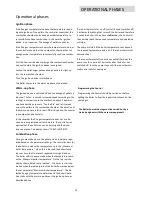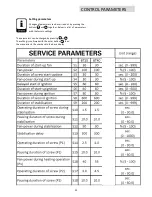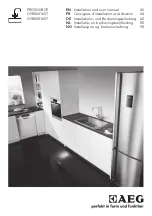
14
DANGER
INSTALLATION
Because the boiler runs at high efficiencies, the
temperature of the flue gases is at times lower
than conventional solid fuel appliances. Although
it is not classed as a condensing appliance, the
low flue gas temperature results in condensation
occurring within the flue. Any chimney flue sys-
tem must therefore be able to withstand the ef-
fects of condensate and operate under wet condi-
tions (designation letter W). In addition it should
be soot fire resistant and able to withstand the
corrosive effects of flue products generated by
solid fuels (designation G and 3 respectively). If
installation is into an existing masonry chimney
then it will require re
-
lining with a liner meeting
the specification described above. Existing con-
crete or clay lined chimneys are not suitable for
this boiler and must be lined as described above.
All installations must be in accordance with Build-
ing Regulations Approved Document J.
Any existing chimney must be clear of obstruction
and have been swept clean immediately before
installation of the lining system. Where the chim-
ney is believed to have previously served an
open fire installation it is possible that the higher
flue gas temperature from a closed appliance
may loosen deposits that were previously firmly
adhered, with the consequent risk of flue block-
age. It is therefore recommended that the chim-
ney be swept a second time within a month of
regular use after installation.
If there is no existing chimney then any new sys-
tem must be to the designation described above
and in accordance with Building Regulations Ap-
proved Document J.
Insufficient flue draught or a badly designed flue
can cause a fire which can spread from the burner
on to the pellet feed screw and then spread to the
pellets in the silo.
This must not
happen however a
safety extinguishing valve is fitted as standard
NOTE this is not a substitute for a correct flue de-
sign. See Page18
Prescribed fuel
This boiler is designed for the combustion of
wood pellets. The use of other fuels is prohibited.
Wood pellets are cylindrical and made from wood
without additives or chemical binders. The pellets
must have specific dimensions ( as below) and a
low moisture level.
STREBEL recommends pellets with a diameter of
6 to 8 mm and length of 10 to 30 mm to DIN
ENplus A1 as referred to in EN 14961
-
2 A1
More information on page 28
The connection to the Boiler flue outlet must not
be reduced in diameter.
It will be necessary to fit an
adapter in the Flue pipe connection to increase the Flue
diameter to the required minimum Flue diameter of 150
mm (as previously stipulated) to comply with U.K. regu-
lations
All joints in the connection between the Boiler and
the chimney must be made gastight using fire ce-
ment and where necessary fire
-
proof rope infill.
The boilers have a flue gas connector that allows
connection to either a masonry chimney or a pre-
fabricated factory made insulated metal chimney
in accordance with the manufactures instructions.
NOTE: A chimney height of not less than 4.5 metres
( the outlet from the chimney should be above the
roof of the building in accordance with the provisions
of Building Regulations Approved Document )
measured vertically from the outlet of the boiler to
the top of the chimney should be satisfactory. Alter-
natively the calculation procedure given in EN
13384
-
1 may be used as the basis for deciding
whether a particular chimney design will provide suf-
ficient draught.
DANGER
Installation & connection to the chimney.
A chimney/flue specialist must be used to calcu-
late chimney sizing and positioning in accordance
with regulations in force. Part J of the Building reg-
ulations refers to additional provisions for applianc-
es burning solid fuel with a rated output of up to
50kw
In order for the boiler to perform satisfactorily the
chimney height/design must be sufficient to ensure
an adequate draught of approximately
15 Pa for the
Biotec 40 and 12 pa for the Biotec 25
so as to
clear the products of combustion and prevent smoke
problems into the room. A draught stabiliser should
be fitted to the Flue to maintain stable draught condi-
tions.















































